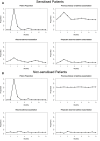Association of asthma exacerbations with paper mulberry (Broussenetia papyrifera) pollen in Islamabad: An observational study
- PMID: 37651635
- PMCID: PMC10471151
- DOI: 10.7189/jogh.13.04091
Association of asthma exacerbations with paper mulberry (Broussenetia papyrifera) pollen in Islamabad: An observational study
Abstract
Background: Although the role of airborne plant pollen in causing allergic rhinitis has been established, the association of concentrations of paper mulberry (Broussenetia papyrifera) pollens in the air and incidence of asthma exacerbations has not, despite an observed increase in the number of asthma patients attending physician clinics and hospital Accident and Emergency (A&E) Departments during the paper mulberry pollen season. We aimed to assess the association between paper mulberry pollen concentrations (typically peaking in March each year) and asthma exacerbations in the city of Islamabad.
Methods: We used three approaches to investigate the correlation of paper mulberry pollen concentration with asthma exacerbations: A retrospective analysis of historical records (2000-2019) of asthma exacerbations of patients from the Allergy and Asthma Institute, Pakistan (n = 284), an analysis of daily nebulisations in patients attending the A&E Department of the Pakistan Institute of Medical Sciences (March 2020 to July 2021), a prospective peak expiratory flow rate (PEFR) diary from participants (n = 40) with or without asthma and with or without paper mulberry sensitisation. We examined associations between pollen data and asthma exacerbations using Pearson correlation.
Results: We found a strong positive correlation between mean paper mulberry pollen counts and clinical records of asthma exacerbations in patients sensitised to paper mulberry (Pearson correlation coefficient (r) = 0.86; P < 0.001), but not in non-sensitised patients (r = 0.32; P = 0.3). There was a moderate positive correlation between monthly nebulisation counts and pollen counts (r = 0.56; P = 0.03), and a strong negative correlation between percent predicted PEFR and pollen counts in sensitised asthma patients (r = -0.72, P < 0.001). However, these correlations were of low magnitude in the non-sensitised asthma (r = -0.16; P < 0.001) and sensitised non-asthma (r = -0.28; P < 0.001) groups.
Conclusions: Our three approaches to analysis all showed an association between high paper mulberry pollen concentration in Islamabad and asthma exacerbations. Predicting pollen peaks could enable alerts and mobilise strategies to proactively manage these peaks of asthma exacerbations.
Copyright © 2023 by the Journal of Global Health. All rights reserved.
Conflict of interest statement
Disclosure of interest: The authors completed the ICMJE Disclosure of Interest Form and disclose no relevant interests.
Figures




Similar articles
-
Predicting the main pollen season of Broussonetia Papyrifera (paper mulberry) tree.PLoS One. 2024 Feb 2;19(2):e0296878. doi: 10.1371/journal.pone.0296878. eCollection 2024. PLoS One. 2024. PMID: 38306347 Free PMC article.
-
Assessment of the health impact of paper mulberry (Broussonetia papyrifera L.), an invasive plant species in Islamabad, Pakistan.Geospat Health. 2019 Nov 12;14(2). doi: 10.4081/gh.2019.727. Geospat Health. 2019. PMID: 31724384
-
Immunoglobulin E reactivity and allergenic potency of Morus papyrifera (paper mulberry) pollen.J Investig Allergol Clin Immunol. 2013;23(3):168-75. J Investig Allergol Clin Immunol. 2013. PMID: 23967755
-
The associations between daily spring pollen counts, over-the-counter allergy medication sales, and asthma syndrome emergency department visits in New York City, 2002-2012.Environ Health. 2015 Aug 27;14:71. doi: 10.1186/s12940-015-0057-0. Environ Health. 2015. PMID: 26310854 Free PMC article.
-
[Airborne pollens in Wuhan urban area and its correlation with hospital visits of allergic rhinitis patients from 2017 to 2018].Zhonghua Yu Fang Yi Xue Za Zhi. 2021 May 6;55(5):620-626. doi: 10.3760/cma.j.cn112150-20210312-00248. Zhonghua Yu Fang Yi Xue Za Zhi. 2021. PMID: 34034402 Chinese.
References
-
- Global Asthma Network. The Global Asthma Report 2018. Auckland, New Zealand: Global Asthma Network; 2018.
-
- World Health Organization. World Health Report. Geneva: World Health Organization; 2018.
-
- Asher MI, Montefort S, Björkstén B, Lai CK, Strachan DP, Weiland SK, et al. Worldwide time trends in the prevalence of symptoms of asthma, allergic rhinoconjunctivitis, and eczema in childhood: ISAAC Phases One and Three repeat multicountry cross-sectional surveys. Lancet. 2006;368:733-43. 10.1016/S0140-6736(06)69283-0 - DOI - PubMed
